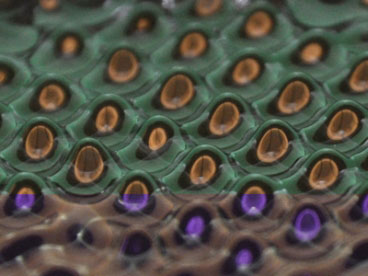Imec Taiwan today signed the co-funding contract with the Taiwanese Ministry of Economic Affairs (MOEA) for its R+D activity Imec Taiwan Innovation Centre (ITIC). ITIC's goal is to expedite applied research projects with industry and academia that will result in electronic designs, components and technology solutions.
Oct 20th, 2010
Read more
Efforts to store energy in carbon nanotubes described at AVS Meeting in Albuquerque.
Oct 20th, 2010
Read more
 Experiments in which fluid droplets mimic the odd behavior of subatomic particles recall an abandoned interpretation of quantum mechanics.
Experiments in which fluid droplets mimic the odd behavior of subatomic particles recall an abandoned interpretation of quantum mechanics.
Oct 20th, 2010
Read more
A research group at the University of South Australia is working on techniques to permanently bind antibacterial coatings to medical devices by binding them to a polymer layer.
Oct 20th, 2010
Read more
Micro-scaled photovoltaic devices may one day be used to deliver chemotherapeutic drugs directly to tumors, rendering chemotherapy less toxic to surrounding tissue.
Oct 20th, 2010
Read more
Research funded by DARPA is pushing the limits of battery technology and trying to create some of the tiniest batteries on Earth, the largest of which would be no bigger than a grain of sand.
Oct 19th, 2010
Read more
University of Virginia chemical engineers Robert J. Davis and Matthew Neurock have uncovered the key features that control the high reactivity of gold nanoparticles in a process that oxidizes alcohols in water. The research is an important first step in unlocking the potential of using metal catalysts for developing biorenewable chemicals.
Oct 19th, 2010
Read more
The 2010 Nobel Prize in Physics went to the two scientists who first isolated graphene, one-atom-thick crystals of graphite. Now, a researcher with the University of Houston Cullen College of Engineering is trying to develop a method to mass-produce this revolutionary material.
Oct 19th, 2010
Read more
Critical component of quantum communication device may enable cryptography.
Oct 19th, 2010
Read more
In the world of the very small, researchers at Shanxi University in China have announced progress in understanding the single-molecule magnet, which combines the classical macroscale properties of a magnet with the quantum properties of a nanoscale entity.
Oct 19th, 2010
Read more
University of Illinois chemists have developed a simple sensor to detect an explosive used in shoe bombs. It could lead to inexpensive, easy-to-use devices for luggage and passenger screening at airports and elsewhere.
Oct 19th, 2010
Read more
Twisting spires, concentric rings, and gracefully bending petals are a few of the new three-dimensional shapes that University of Michigan engineers can make from carbon nanotubes using a new manufacturing process.
Oct 19th, 2010
Read more
Some bacteria react to the cold by subtly changing the chemistry of their outer wall so that it remains pliable as temperatures drop. Scientists identified a key protein in this response mechanism a few years ago, but the question of how bacteria sense cold in the first place remained a mystery. Based on a new study, the answer is: They use a measuring stick.
Oct 19th, 2010
Read more
Forever linked by a single molecule - Nobel team reunites for Rice's Buckyball Discovery Conference
Oct 19th, 2010
Read more
In cold weather, many children can't resist breathing onto a window and writing in the condensation. Now imagine the window as an electronic device platform, the condensation as a special conductive gas, and the letters as lines of nanowires.
Oct 19th, 2010
Read more
The long-held dream of creating atomically precise three-dimensional structures in a manufacturing environment is approaching reality, according to the top scientist at a company making tools aimed at that ambitious goal.
Oct 19th, 2010
Read more


 Subscribe to our Nanotechnology News feed
Subscribe to our Nanotechnology News feed